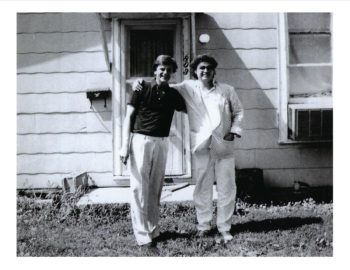
In 1986, Don and Phil Everly returned to their hometown of Shenandoah for a concert, parade, class reunion and visit to their childhood home, which now serves as a museum and a host site for the Everly Heritage Day event on June 22. Photo courtesy of Shenandoah Chamber & Industry Association
By Michael Swanger
If you think that all you have to do — or can do — is dream to experience the magic of the Everly Brothers one more time, guess again.
All you have to do is hop in your car and drive to Shenandoah on June 22 to attend Everly Heritage Day.
The annual festival is where you can relive the glory days of Don and Phil Everly by visiting the Everly Brothers Childhood Home, which has been converted into a museum, as well as take in a concert by The Everly Brothers Experience featuring The Zmed Brothers and The Bird Dog Band. You can walk in the footsteps of the pioneering rock ’n’ roll duo by visiting Everly Brothers-related sites like the George Jay Drug Co. & Hallmark Shoppe, the Memorial Armory, Depot Deli and the site of their historic 1986 homecoming concert. Along the way, you might also discover how Shenandoah played a key role in shaping early rock ’n’ roll and its most popular media format at the time — radio.
“The beginnings of rock ’n’ roll started in Shenandoah,” said Bill Hillman, who organized the 1986 Everly Brothers homecoming concert.
Hillman, 65, owns the Depot Deli and led the charge in 2005 to save and preserve the Everlys’ small childhood home which was originally located on 6th Avenue. In 2006, it was moved to 800 West Sheridan Ave., where it stands next to the Greater Shenandoah Historical Society Museum. Hillman said the Everly Brothers Childhood Home and Everly Heritage Day festival tell entertaining and informative stories about the roots of rock ’n’ roll.
“Most people know that the Everly Brothers lived in Shenandoah, but don’t understand the importance of how they were among the originators of rock ’n’ roll music and how they brought country music into rock ’n’ roll,” he said. “They were part of the first class inducted into the Rock and Roll Hall of Fame and they got their start in Shenandoah because it was a place where musicians could get a full-time job playing music.”
Before the Everly Brothers became prodigious hit makers with songs like “Bye Bye Love,” “Wake Up Little Susie,” “All I Have To Do Is Dream,” “Cathy’s Clown” and “When Will I Be Loved,” they cut their teeth in the music business by playing with their family’s band during their childhood and teenage years in Shenandoah from 1945 to 1953.
TO READ THE ENTIRE STORY AND OTHER FASCINATING STORIES ABOUT IOWA HISTORY, subscribe to Iowa History Journal. You can also purchase back issues at the store.
